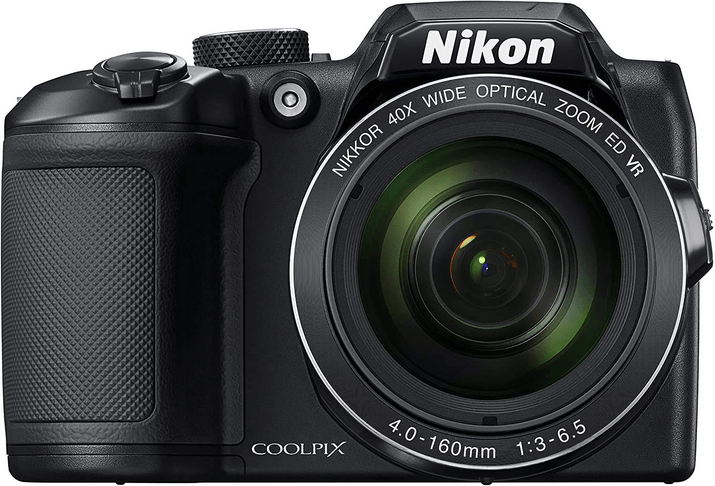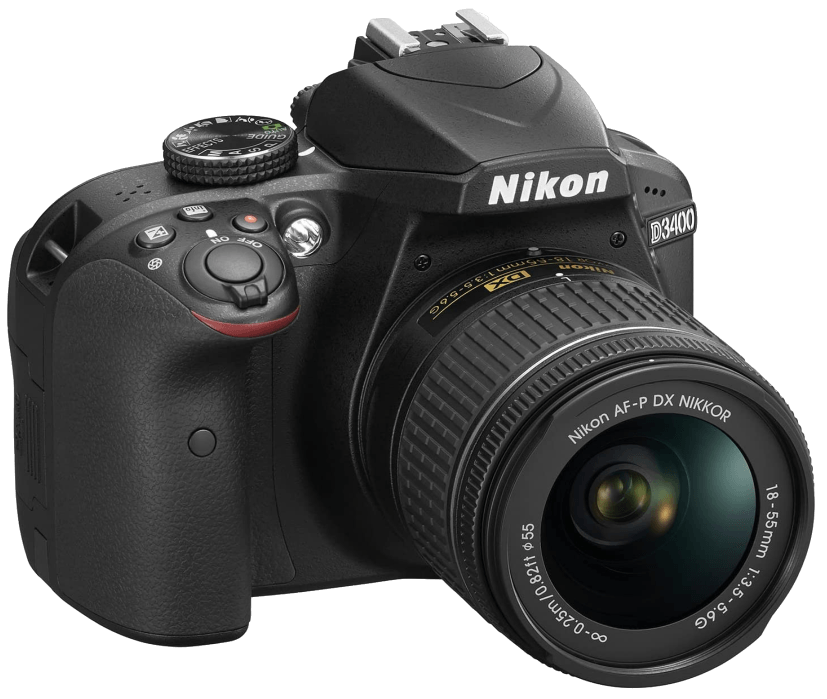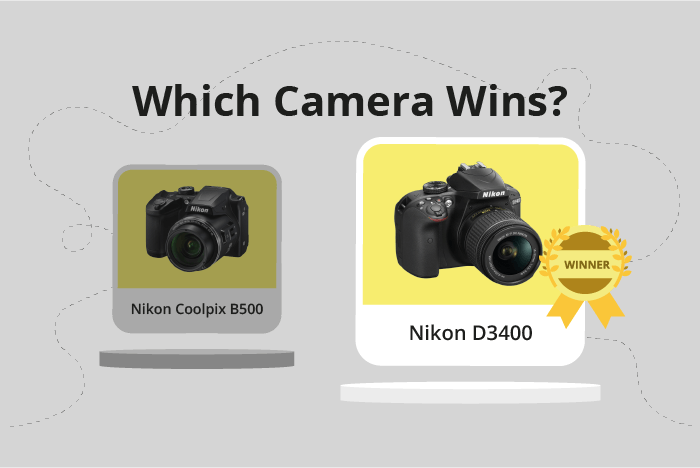Nikon Coolpix B500 vs D3400 Comparison
Nikon Coolpix B500

Nikon D3400

The Nikon D3400 takes the lead with a score of 61/100, while the Nikon Coolpix B500 trails by 8 points at 53/100. Both cameras were released in 2016, with the D3400 being announced on August 17th and the B500 on February 23rd. They share some common specifications, such as the release year and the renowned Nikon brand.
The D3400, a DSLR camera, boasts a higher score and a more compact design, measuring 124 x 98 x 76mm and weighing 445g. This makes it more portable and easier to handle than the B500. However, the B500, a bridge camera, is more affordable with a launch price of $300 compared to the D3400’s $650. Its dimensions are 114 x 78 x 95mm, and it weighs 541g.
While the Nikon D3400 emerges as the better camera due to its higher score and compact design, the Nikon Coolpix B500 remains an attractive option for those on a budget.
Nikon Coolpix B500 vs D3400 Overview and Optics
The Nikon D3400 comes out ahead in our optics comparison with a score of 65/100, while the Nikon Coolpix B500 trails behind at 53/100. Both cameras share some common specifications, such as having CMOS sensors and offering different aspect ratios, with the B500 having a 4:3 ratio and the D3400 having a 3:2 ratio.
The D3400 leads the way with its superior megapixels count of 24.2, compared to the B500’s 16 megapixels. Additionally, the D3400 has a higher DXOMARK score of 86 for its sensor, while the B500 has a score of 72, and the D3400 has a larger APS-C sensor size compared to B500’s 1/2.3″ sensor. The D3400 also has a more advanced processor, the Expeed 4, and a Nikon F DX lens mount, allowing users to change lenses for various photography needs.
On the other hand, the B500 has a faster shooting speed of 7, compared to the D3400’s 5, and features image stabilization, which the D3400 lacks. This can be helpful for users who struggle with camera shake or want to capture fast-moving subjects.
To conclude, the Nikon D3400 has a clear advantage in terms of image quality and flexibility due to its higher megapixels, better sensor performance, and interchangeable lens mount. However, the Nikon Coolpix B500 offers a faster shooting speed and image stabilization, making it a viable choice for those who prioritize these features. Ultimately, the choice between these two cameras will depend on the individual user’s preferences and photography requirements.
Nikon Coolpix B500 vs D3400 Video Performance
The Nikon Coolpix B500 emerges as the winner in the video capabilities comparison with a score of 70/100, while the Nikon D3400 trails behind with a score of 56/100. This 14-point difference highlights the superior video features of the B500.
Both cameras offer Full HD video resolution with maximum dimensions of 1920 x 1080 and a 60fps frame rate. These shared specifications ensure that both the B500 and D3400 can capture high-quality, smooth videos.
The B500 outperforms the D3400 in terms of additional video features. The most notable advantage is the presence of built-in time-lapse functionality. This allows users to create stunning time-lapse videos without the need for external equipment or software, enhancing the overall video experience.
On the other hand, the D3400 does not surpass the B500 in any specific video capabilities. However, it is important to note that it still provides the same core video specifications as the B500, ensuring good video quality.
Taking all factors into consideration, the Nikon Coolpix B500 is the better choice when prioritizing video capabilities. Its built-in time-lapse functionality sets it apart from the Nikon D3400, providing users with additional creative options. While the D3400 does not excel in video features, it remains a solid option for those who are satisfied with the core video specifications shared with the B500.
Nikon Coolpix B500 vs D3400 Features and Benefits
The Nikon Coolpix B500 and Nikon D3400 both have a feature score of 54 out of 100. Analyzing their specifications reveals similarities and differences that contribute to the score.
Both cameras share some common features. They have a 3-inch screen size and a screen resolution of 921,000 dots. Neither camera has a touchscreen or GPS. They also both offer Bluetooth connectivity.
The Coolpix B500 surpasses the D3400 in two aspects. It has a flip screen, providing more flexibility for framing shots, especially in difficult angles. Additionally, the B500 also has Wi-Fi connectivity, allowing for easy image sharing and remote control options.
On the other hand, the D3400 has no significant advantages over the B500 in terms of features. The lack of Wi-Fi and a flip screen puts it at a disadvantage compared to the B500.
Considering these points, the Nikon Coolpix B500 stands out with its flip screen and Wi-Fi capabilities, making it a more versatile and user-friendly camera. The Nikon D3400, while sharing a similar feature score, does not present any notable advantages over the B500. Therefore, the Coolpix B500 is the better choice for those prioritizing flexibility and connectivity in their camera features.
Nikon Coolpix B500 vs D3400 Storage and Battery
The Nikon D3400 wins the storage and battery comparison with a score of 45/100, while the Nikon Coolpix B500 scores 43/100. Both cameras share similarities in storage, having one memory card slot each and accepting SD, SDHC, and SDXC memory cards.
The D3400 surpasses the B500 in battery life, offering 1200 shots per charge compared to the B500’s 600 shots. This extended battery life is due to the D3400’s use of the EN-EL14a battery type. On the other hand, the B500 uses 4 AA batteries, which are more readily available and easier to replace in a pinch.
The B500 holds an advantage in charging, as it supports USB charging, while the D3400 does not. This feature allows for more convenient charging options, especially when traveling or on-the-go.
Taking these factors into account, the Nikon D3400’s significantly longer battery life makes it the better choice for extended shooting sessions. However, the Coolpix B500’s USB charging capability and use of AA batteries offer flexibility and convenience in various situations.
Nikon Coolpix B500 vs D3400 – Our Verdict
Are you still undecided about which camera is right for you? Have a look at these popular comparisons that feature the Nikon Coolpix B500 or the Nikon D3400:

